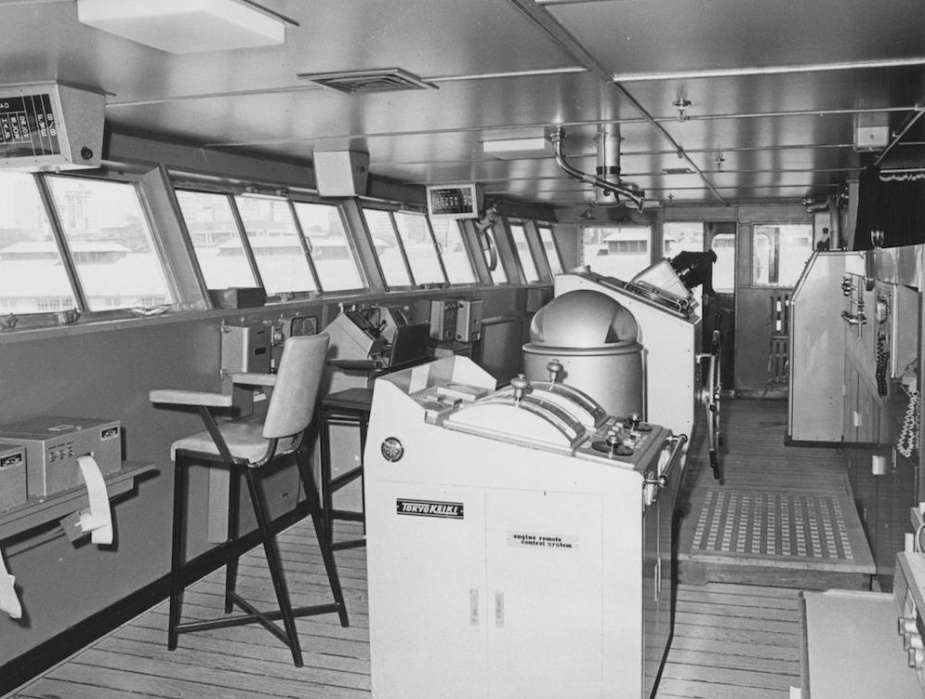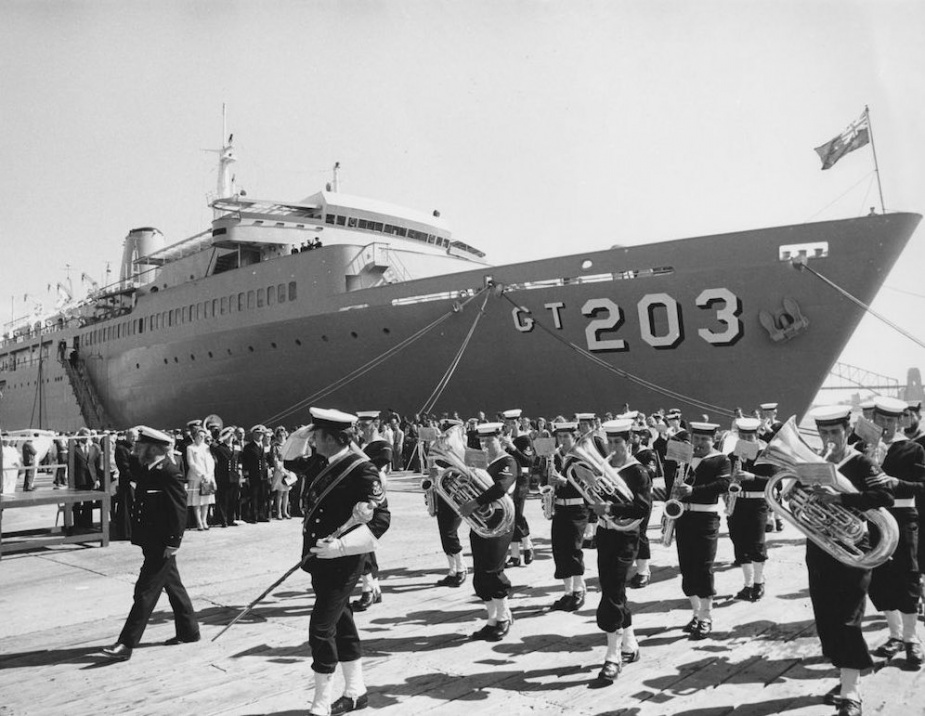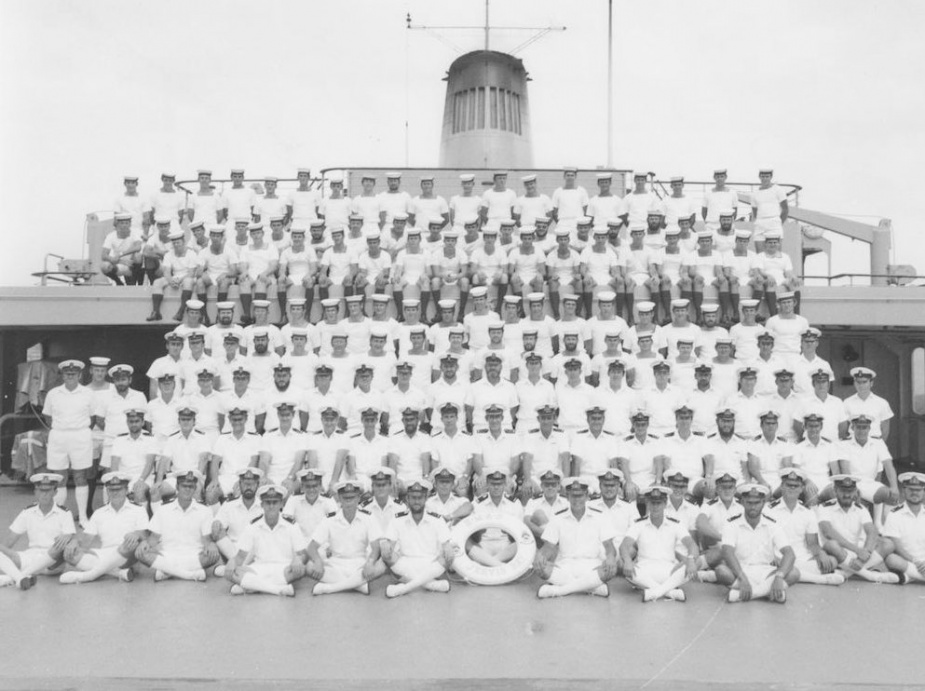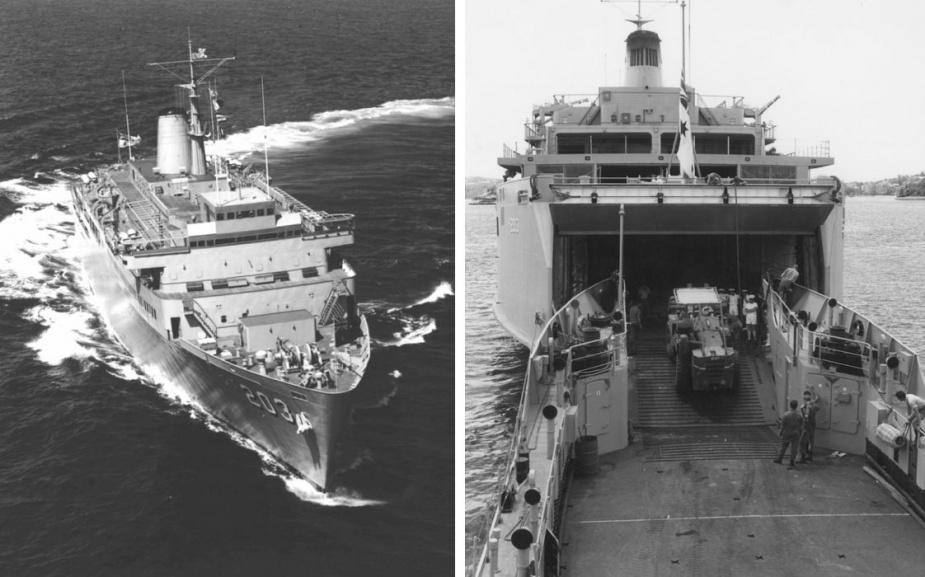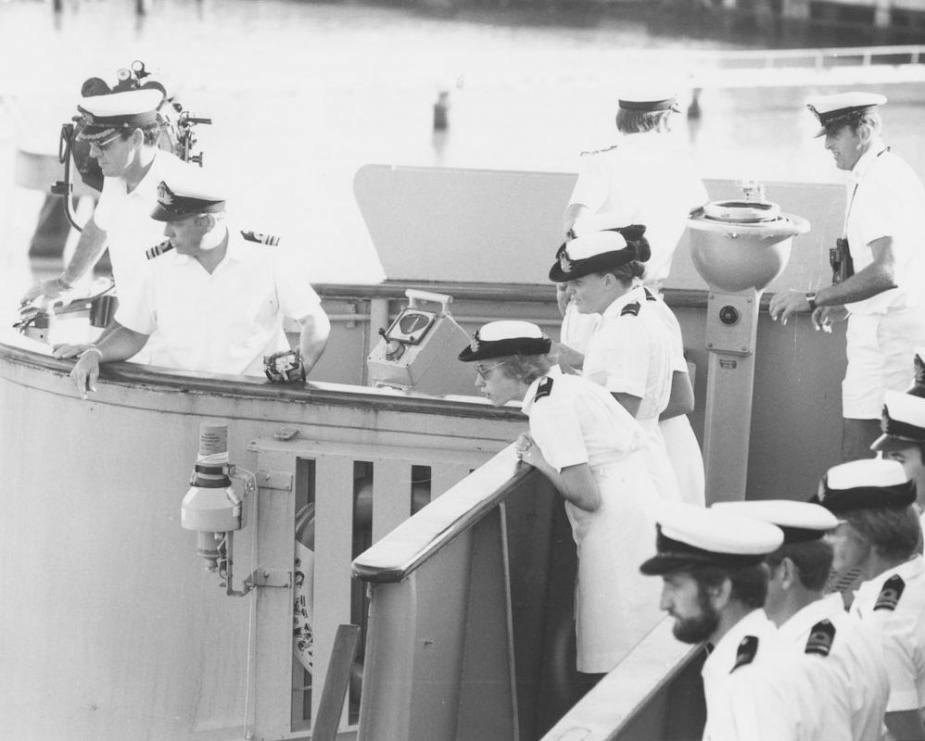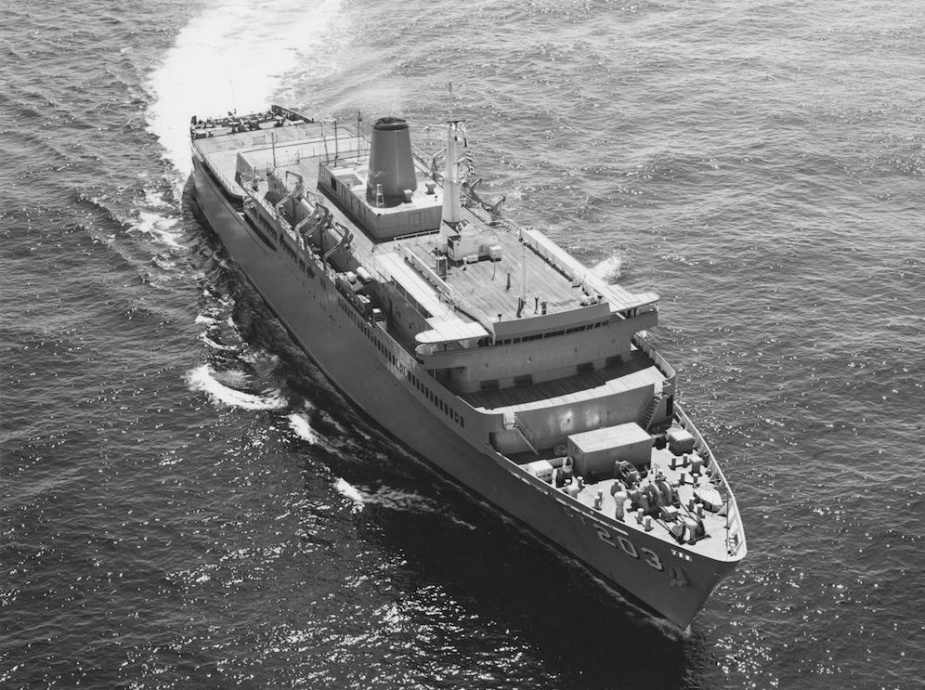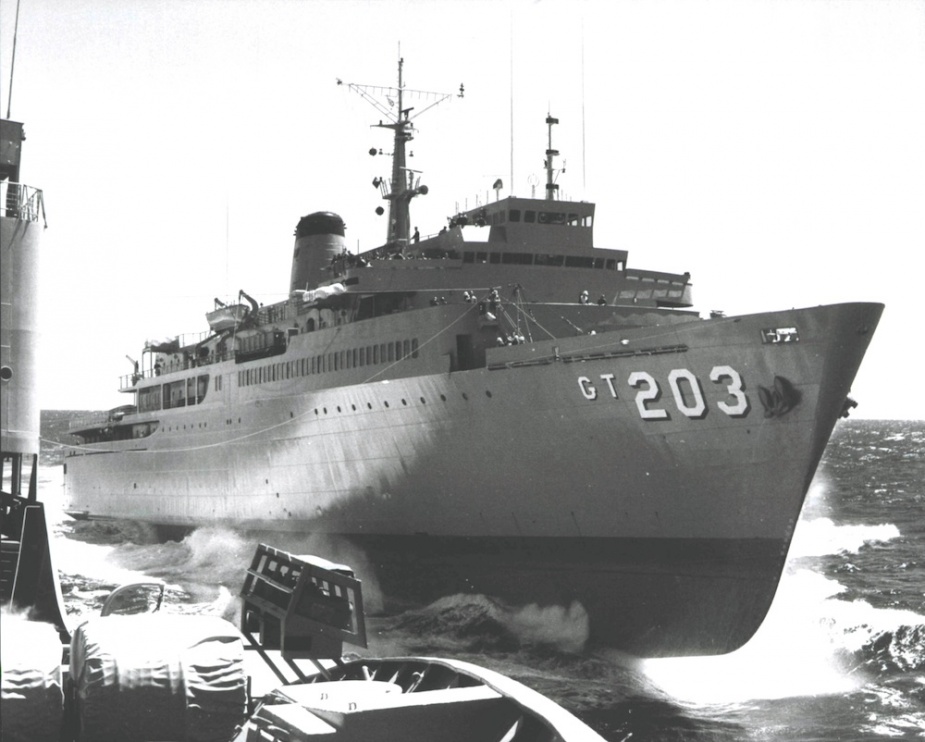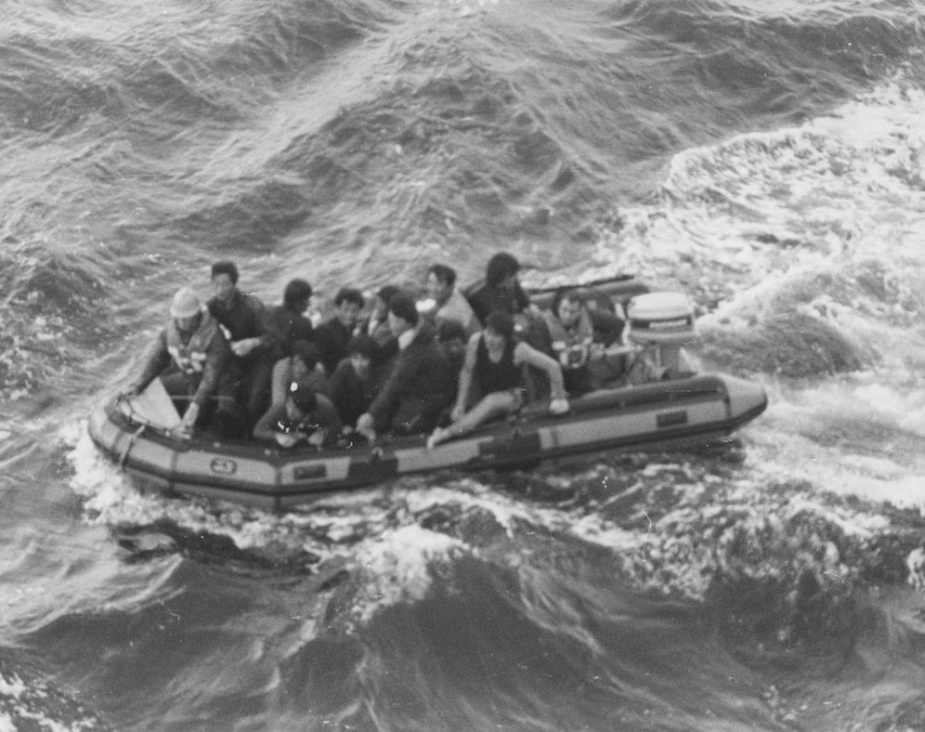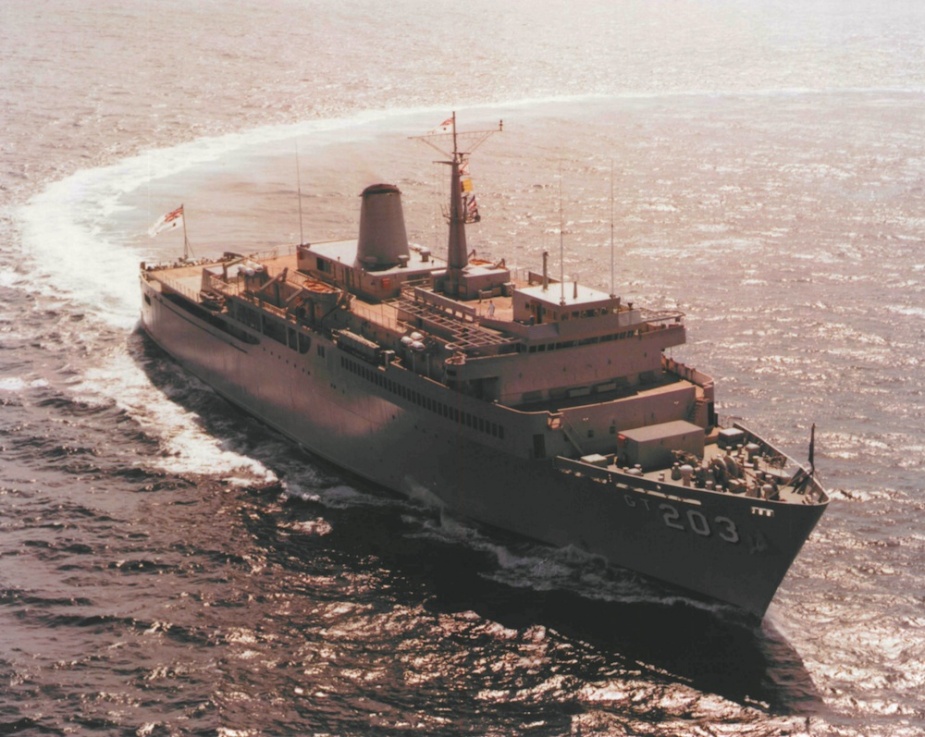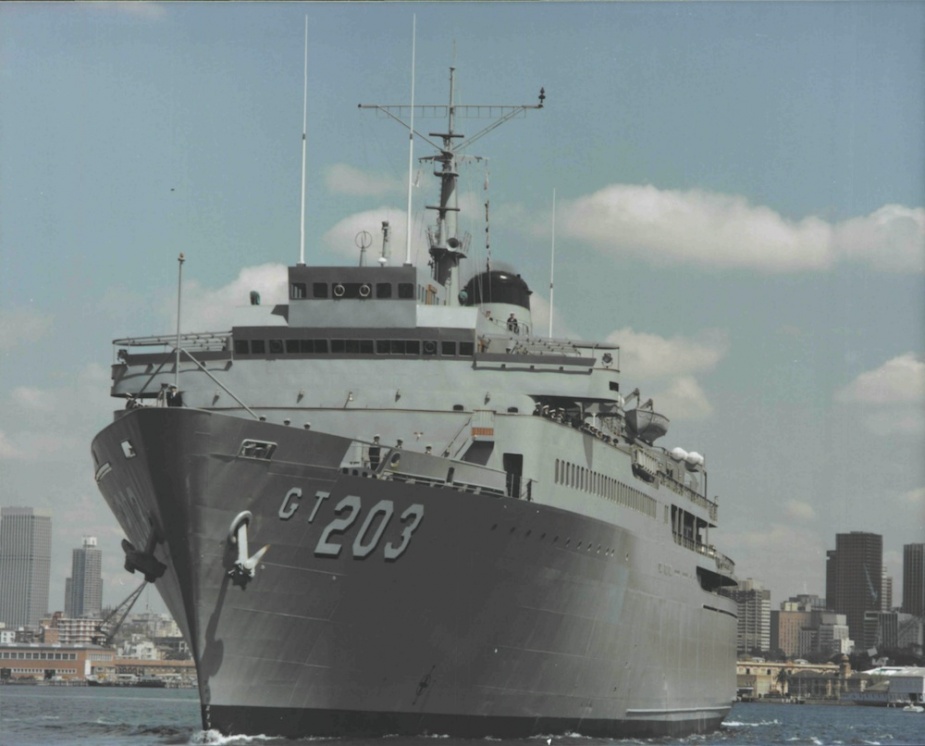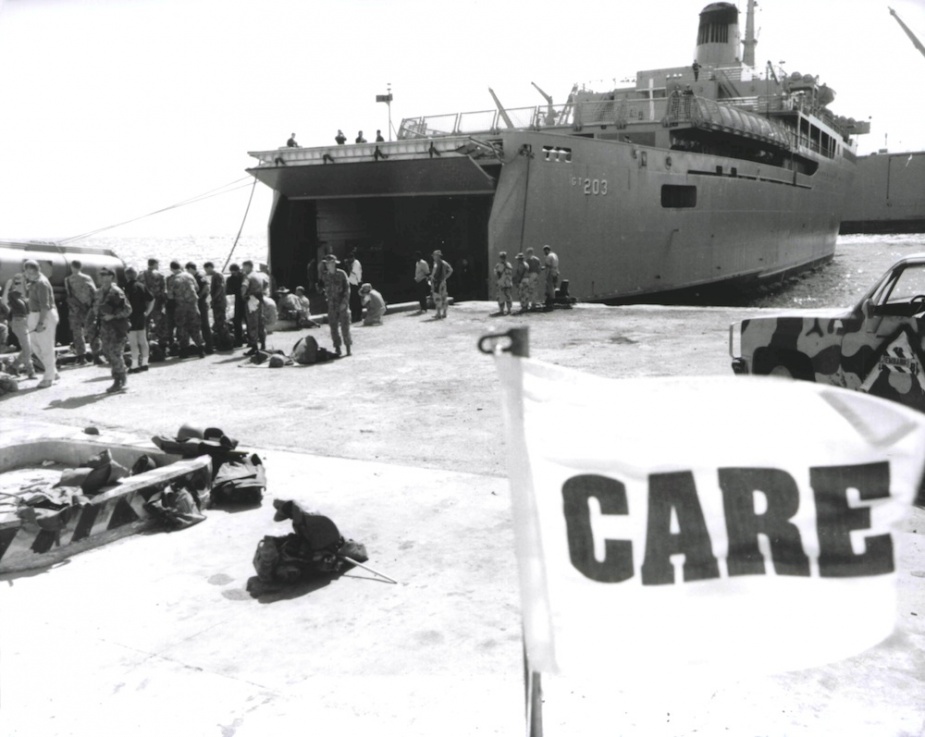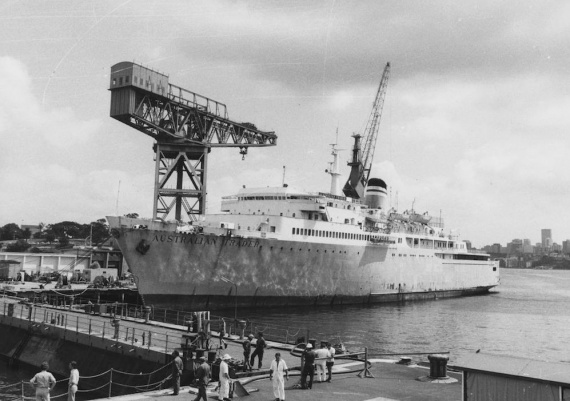
HMAS Jervis Bay was laid down at the Newcastle State Dockyard as the merchant ship Australian Trader on 27 September 1967. She was built for the Australian Shipping Commission (later the Australian National Line) as a roll-on roll-off vehicle ferry to service the Bass Strait run. She was launched on 17 February 1969. On completion of her merchant service in 1977 Australian Trader was acquired by the Royal Australian Navy (RAN) as a replacement for the training ship HMAS Duchess which decommissioned on 23 October 1977.
Australian Trader was commissioned into the RAN as HMAS Jervis Bay at Garden Island, Sydney, under the command of Commander Joe Morrice on 25 August 1977, the 38th anniversary of the commissioning of HMS Jervis Bay. Her primary role was to train junior officers in seamanship and navigation. She was equipped with classrooms and a purpose built training bridge for that purpose, and conducted up to six training cruises per year. Her secondary role was that of military sea lift which went some way in addressing the capability lost when the fast troop transport and former aircraft carrier HMAS Sydney (III) decommissioned.
Following her commissioning, Jervis Bay underwent a dockyard conversion and a period of sea trials before embarking on her first training cruise in February 1978 during which she visited Hobart and Port Arthur for the first time as an RAN vessel. Her second cruise took her overseas visiting New Zealand in March and April where members of the Royal New Zealand Navy (RNZN) were embarked for sea training. Jervis Bay often provided training to officers and sailors of the RNZN and on occasion provided training for members of other Commonwealth navies, including the Royal Navy. She was a regular visitor to Australia"s neighbours over the years of her commission including New Zealand, Fiji, Papua New Guinea, Indonesia, New Caledonia, the Solomon Islands, Singapore, Malaysia, Vanuatu, the Philippines and Samoa.
As well as serving in her training role, Jervis Bay was also involved in regular fleet exercises and humanitarian tasks. She participated in Exercise GOLDEN SAND TWO in November and December 1980, Exercise KANGAROO 81 in October 1981, Exercise KANGAROO 83 in September 1983, Exercise KANGAROO 86 in October and November 1986, Exercise DIAMOND DOLLAR 87 in October 1987, Exercise TASMAN LINK in May 1988, Exercise SWIFT EAGLE 90 in August 1990, Exercise KANGAROO 92 in March and April 1992, and the Fleet Concentration Periods in February 1984, February and September 1985 and November 1991.
In 1980 she became the first RAN ship to embark females when six midshipmen of the Women’s Royal Australian Navy Service (WRANS) embarked on 28 April for a three week training cruise. The only distinction made between the RAN and WRANS members was that the WRANS were assigned their own sleeping and ensuite facilities.
Unfortunately the WRANS"s cruise was cut short when Jervis Bay, along with HMAS Vampire (II), was retasked to observe the re-entry of two Chinese inter-continental ballistic missiles which splashed down in the South Pacific Ocean. As females, at that time, could not yet undertake overseas deployments, the WRANS were disembarked at Cairns on 10 May while Jervis Bay and Vampire proceeded into the South Pacific. The two ships observed the re-entry of the first missile on 18 May and the second three days later some 750 nautical miles north north west of Fiji. Eighteen ships of the People’s Liberation Army-Navy were present in the recovery area. (Navy News - 30 May 1980)
In March 1983 Jervis Bay, with 20 soldiers from 30 Terminal Squadron Detachment embarked, assisted in the relocation of 75 Squadron Royal Australian Air Force (RAAF) from RAAF Base Butterworth, Malaysia, to Darwin. She conducted normal sea training concurrently with the sea-lift task. Some 600 tonnes of RAAF cargo was embarked at both Singapore and Butterworth, and Jervis Bay arrived in Darwin on 4 April.
In January 1984, a film crew embarked to shoot scenes for the "Bodyline" television mini-series. Jervis Bay was cast as the merchant vessel SS Orantes which had transported Douglas Jardine’s England cricket team to Australia for the infamous ‘Bodyline’ Ashes test series of 1932-33. Some members of the ship’s company made their film debuts as extras in the production. (Navy News - 27 January 1984)
In October 1986 Jervis Bay participated in the RAN 75th Anniversary Fleet Review which included some 40 naval vessels from seven countries. She was host ship to RFA Olmeda for the period of the review which involved a number of professional and social exchanges between the two crews. Jervis Bay was the first vessel to take up her review position at the No 2 Point Piper buoy on the morning of 2 October and the next day she hosted some 40 guests on board for the start of the Sydney-Montagu Island Yacht Race. With 290 midshipmen from the Australian Defence Force Academy embarked, the ship dressed overall for inspection by the Admiral of the Fleet, His Royal Highness Prince Philip, Duke of Edinburgh, on 4 October. She later departed Sydney on 13 October to participate in Exercise KANGAROO 86 in Queensland waters.
Following a coup in Fiji on 14 May 1987, Jervis Bay was ordered to make all necessary preparations to sail while other RAN vessels headed for the South Pacific nation under the auspices of Operation MORRIS DANCE. Jervis Bay underwent emergency modifications at Cockatoo Island Dockyard having a flight deck fitted to enable her to conduct helicopter operations.
Jervis Bay departed Sydney to relieve HMAS Success (II) in Fiji on 1 June and conducted flight trials on her new flight deck that morning. A Sea King helicopter from 817 Squadron was the first aircraft to land aboard Jervis Bay at 11:15. The following day, while off the Queensland coast, the ship was notified that Operation MORRIS DANCE had been suspended and that her presence in Fiji was no longer required.
The ship was placed at four hours notice for sea and the ship"s company recalled on 25 September when a second military coup occurred in Fiji. A contingency plan was put in place, involving Jervis Bay, for the evacuation of Australian nationals from Fiji if the situation deteriorated further. However, as it transpired that Jervis Bay was not required and she instead proceeded to Queensland waters to participate in Exercise DIAMOND DOLLAR 87 providing sea-lift for Army equipment and personnel.
The ship and her crew started 1988 in fine style when she was awarded the Duke of Gloucester"s Cup as the RAN unit displaying the highest level of overall proficiency through the previous year. The cup was presented by His Excellency the Governor-General The Right Honourable Sir Ninian Stephen, AK, GCMG, GCVO, KBE, on the ship"s flight deck on 5 January.
In the evening of 21 February, having just completed pilotage training in Queen Charlotte Sound, New Zealand, Jervis Bay intercepted a distress call indicating that a Korean fishing trawler, Dong Chang No. 3, was sinking some 35 nautical miles north of Cape Jackson. The ship proceeded to the area in heavy and worsening seas and began a systematic search in company with MV Ficus and one aircraft. After little more than five minutes of searching, Leading Seaman Andy Skinner spotted an overturned life raft with 12 survivors clinging to it. In a five metre swell, with winds in excess of 40 knots, Jervis Bay created a lee for the life raft and lowered a sea boat to rescue the survivors. With three sailors still missing the search continued joined by MV James Cook later in the evening and a helicopter the following morning. However, no trace could be found of the missing sailors. The survivors held a traditional Taoist memorial service for their lost crew mates on the ship"s flight deck before setting course for Wellington. (Navy News - 4 March 1988)
On 22 April 1988, Jervis Bay paid her first visit, as a RAN vessel, to the Tasmanian town of Burnie. The following day Burnie formally adopted the ship, building on the strong ties developed between the town and the ship when she was employed as a car ferry before commissioning into the RAN. A scheduled march through the streets of Burnie by the ship"s company was cancelled due to poor weather so the adoption ceremony was instead held on board. A contingent from the crew participated in Burnie"s annual Anzac Day Dawn Service while some were present to witness Her Majesty Queen Elizabeth II proclaim Burnie a city the following day. Jervis Bay returned to Burnie in February 1991 when the ship"s company conducted a Freedom of Entry March through the city on 16 February.
On 20 May 1988 Jervis Bay, along with Stalwart, was once again diverted from training in preparation to assist Australian nationals in a south pacific nation; on this occasion it was Vanuatu where rioting had swept through the capital, Port Vila, the previous week. The two ships arrived on station in the early morning of 23 May under the auspices of Operation SAILCLOTH. Thankfully local police were restoring order ashore and SAILCLOTH was suspended on the morning of 26 May. Both ships departed that morning for Brisbane.
On 11 July Jervis Bay embarked the Flag Officer Naval Support Command, Rear Admiral Tony Horton, AO, RAN, as well members of the Australian Bicentennial Authority and 78 media personnel for the media launch of the Bicentennial Naval Salute scheduled for September 1988. Ironically, Jervis Bay did not participate in the Naval Salute on 26 September; she was in Townsville embarking 121 members of the Bicentennial Military Tattoo Regiment. She spent the next ten weeks circumnavigating Australia transporting the regiment and providing alongside support on its national tour. Her commitment came to an end on 30 November in Melbourne.
In stark contrast to what was a very busy 1988, much of 1989 was spent at Garden Island and Cockatoo Island Dockyards in Sydney, spending some 252 days in refit beginning on 22 February. Material shortages, the discovery of asbestos on board and industrial unrest all combined to blow out the refit"s schedule making a routine period of maintenance anything but that. She was returned to service on 1 November.
On 25 January 1990 while visiting Auckland, New Zealand, Jervis Bay was assigned to Operation DEFERENCE and ordered to North Queensland waters with instructions to standby to evacuate Australian nationals from Bougainville should political tensions there continue to rise. It was the fourth occasion during her commission that Jervis Bay had been diverted from her normal duties due to political unrest in the South Pacific. She arrived in Townsville on 30 January and continued training in North Queensland waters until DEFERENCE was cancelled in April.
On 19 December 1992, Jervis Bay departed Sydney for Mogadishu, Somalia, to provide strategic sea-lift for Operation SOLACE, the Australian Defence Force"s contribution to the US-led operation to bring peace and humanitarian relief to the war torn African nation. Her operations, in concert with those of HMAS Tobruk (II), amounted to Australia"s largest military sea-lift operation since the end of the Vietnam War.
Jervis Bay arrived in Townsville on 22 December where she embarked a detachment of troops from 1RAR and some 800 tonnes of cargo bound for Mogadishu. She entered the SOLACE Area of Operations on 12 January 1993 having refuelled at Darwin and Diego Garcia en route. On arrival Jervis Bay was assigned an anchorage some five and half miles from the port due to the large amount of shipping in the area. Ships from the navies of the USA, Canada, India, France, Turkey and Spain were present while port operations were controlled by US Marines. She was allowed into the port two days later to disembark her troops and cargo. Jervis Bay"s Commanding Officer, Commander Errol Morgan, RAN later related the scene that evening: "The darkened city of Mogadishu, little more than a collection of remains with all buildings stripped of rooves, windows and fittings, took on an eerie appearance at night. Sporadic gun fire was clearly audible/visible in the near vicinity but fortunately no action was directed against Jervis Bay".There were also reports of stray sniper fire into the port.
She departed Mogadishu the following day rendezvousing with Tobruk on 17 January to provide Tobruk"s command team with a comprehensive brief on the situation in Mogadishu. She reverted to her role as a training ship when she arrived in Diego Garcia on 21 January.
Jervis Bay deployed to Somalia for a second time in May arriving in Mogadishu on the 17 May where she embarked troops and equipment for passage back home to Australia. She departed Mogadishu three days later arriving in Townsville on 16 June. (Operation SOLACE - RAN Relief Somalia)
Jervis Bay made her final overseas visit in September 1993 visiting Port Vila in Vanuatu during a training cruise. She arrived back in Sydney on 3 October following the complete failure of the starboard main engine. On 17 December, the Minister for Defence, Senator the Hon. Robert Ray announced that Jervis Bay and Tobruk were to be decommissioned in 1994. Members of the ship"s company travelled to Little Creek Naval Amphibious Base, Norfolk, Virginia, USA, to begin preparations to commission the two ships" replacements; the amphibious vessels HMA Ships Kanimbla (II) and Manoora (II).
HMAS Jervis Bay was decommissioned on 18 April 1994. She was subsequently sold to Voyager Marine Ltd and renamed Agios Andreas (Saint Andrew).
Specifications
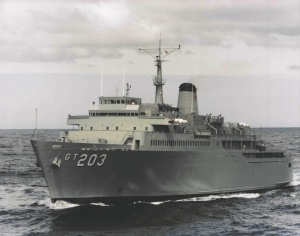 |
| Pennant |
GT203 |
|---|---|
| Builder |
NSW State Dockyard, Newcastle |
| Laid Down |
27 September 1967 |
| Launched |
17 February 1969 |
| Commissioned |
25 August 1977 |
| Decommissioned |
18 April 1994 |
| Dimensions & Displacement | |
| Displacement | 8910 tonne |
| Length | 135.7 metres |
| Beam | 21.5 metres |
| Draught | 6.1 metres |
| Performance | |
| Speed | 17 knots |
| Complement | |
| Crew | 108 |
| Propulsion | |
| Machinery | Two 16-cylinder PC2V400 Pielstick turbo charged diesel engines |
| Horsepower | 6500 bhp |
| Awards | |
| Battle Honours | SOMALIA 1993 |
